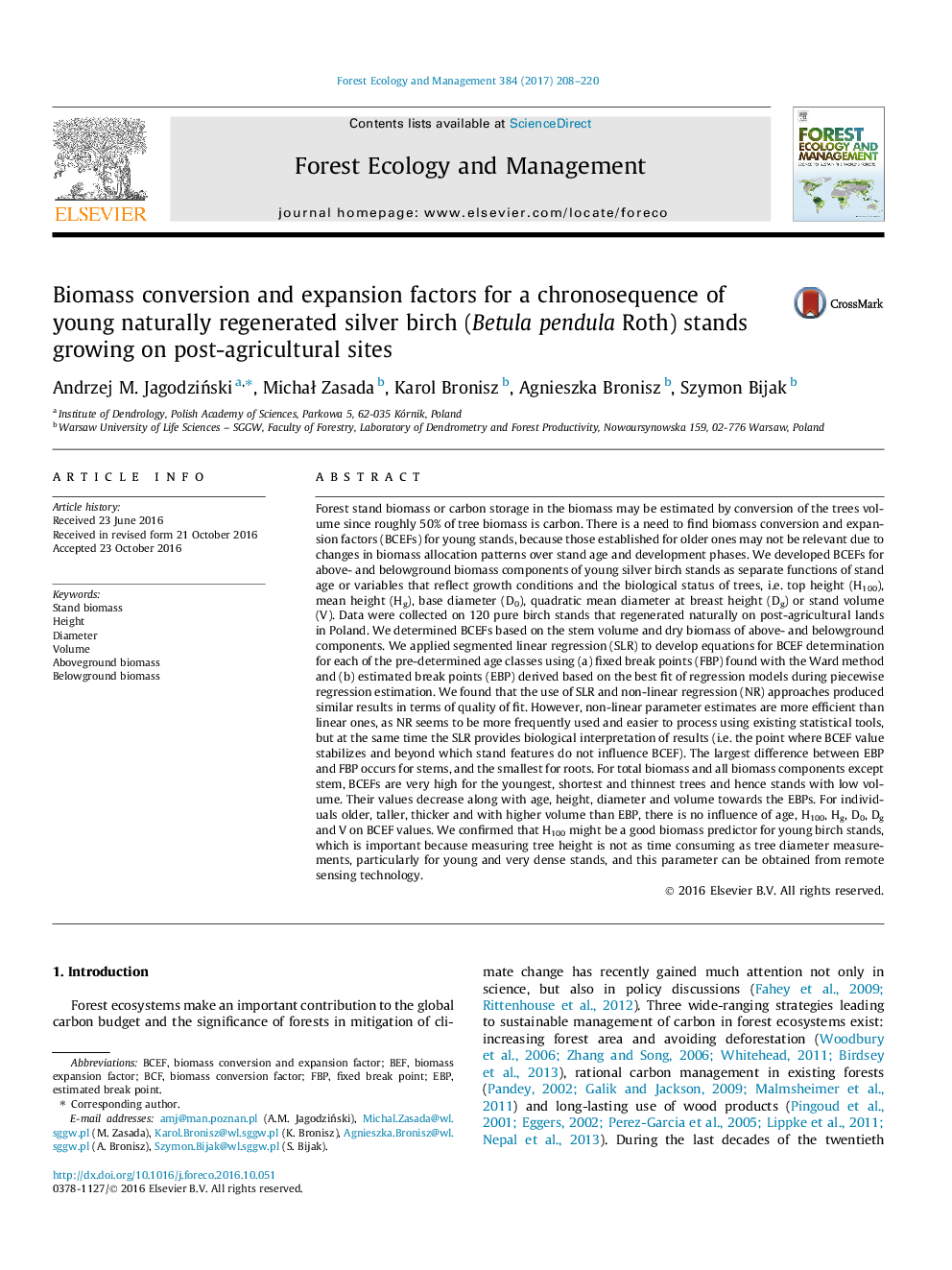| کد مقاله | کد نشریه | سال انتشار | مقاله انگلیسی | نسخه تمام متن |
|---|---|---|---|---|
| 4759625 | 1421374 | 2017 | 13 صفحه PDF | دانلود رایگان |
عنوان انگلیسی مقاله ISI
Biomass conversion and expansion factors for a chronosequence of young naturally regenerated silver birch (Betula pendula Roth) stands growing on post-agricultural sites
دانلود مقاله + سفارش ترجمه
دانلود مقاله ISI انگلیسی
رایگان برای ایرانیان
کلمات کلیدی
موضوعات مرتبط
علوم زیستی و بیوفناوری
علوم کشاورزی و بیولوژیک
بوم شناسی، تکامل، رفتار و سامانه شناسی
پیش نمایش صفحه اول مقاله

چکیده انگلیسی
Forest stand biomass or carbon storage in the biomass may be estimated by conversion of the trees volume since roughly 50% of tree biomass is carbon. There is a need to find biomass conversion and expansion factors (BCEFs) for young stands, because those established for older ones may not be relevant due to changes in biomass allocation patterns over stand age and development phases. We developed BCEFs for above- and belowground biomass components of young silver birch stands as separate functions of stand age or variables that reflect growth conditions and the biological status of trees, i.e. top height (H100), mean height (Hg), base diameter (D0), quadratic mean diameter at breast height (Dg) or stand volume (V). Data were collected on 120 pure birch stands that regenerated naturally on post-agricultural lands in Poland. We determined BCEFs based on the stem volume and dry biomass of above- and belowground components. We applied segmented linear regression (SLR) to develop equations for BCEF determination for each of the pre-determined age classes using (a) fixed break points (FBP) found with the Ward method and (b) estimated break points (EBP) derived based on the best fit of regression models during piecewise regression estimation. We found that the use of SLR and non-linear regression (NR) approaches produced similar results in terms of quality of fit. However, non-linear parameter estimates are more efficient than linear ones, as NR seems to be more frequently used and easier to process using existing statistical tools, but at the same time the SLR provides biological interpretation of results (i.e. the point where BCEF value stabilizes and beyond which stand features do not influence BCEF). The largest difference between EBP and FBP occurs for stems, and the smallest for roots. For total biomass and all biomass components except stem, BCEFs are very high for the youngest, shortest and thinnest trees and hence stands with low volume. Their values decrease along with age, height, diameter and volume towards the EBPs. For individuals older, taller, thicker and with higher volume than EBP, there is no influence of age, H100, Hg, D0, Dg and V on BCEF values. We confirmed that H100 might be a good biomass predictor for young birch stands, which is important because measuring tree height is not as time consuming as tree diameter measurements, particularly for young and very dense stands, and this parameter can be obtained from remote sensing technology.
ناشر
Database: Elsevier - ScienceDirect (ساینس دایرکت)
Journal: Forest Ecology and Management - Volume 384, 15 January 2017, Pages 208-220
Journal: Forest Ecology and Management - Volume 384, 15 January 2017, Pages 208-220
نویسندگان
Andrzej M. JagodziÅski, MichaÅ Zasada, Karol Bronisz, Agnieszka Bronisz, Szymon Bijak,